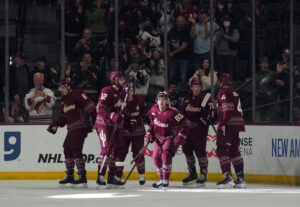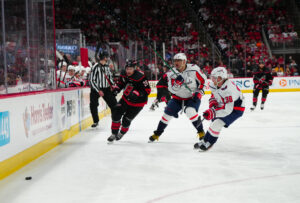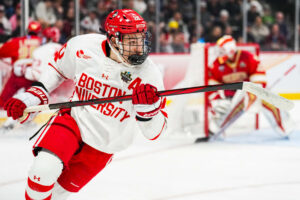Vancouver Canucks Best Draft Class: 1999
The draft year of 1999 was, in a word, awful. Skaters taken in the first round averaged around 370 NHL games played – worse than any other year that decade. And that’s including Vancouver’s famous picks. The Canucks breached the 100-point mark for the first time in their history in 1992-93 and reached the Stanley Cup Final the year after. Then they made some inadvisable trades and a signing or two in an effort to get back there, and… By the time the 1999 draft came around, the Canucks had the third overall pick to work with.
Swedish Twins!
The issue, of course, is that there were two players that general manager Brian Burke wanted – Henrik Sedin and Daniel Sedin. He didn’t initially, being very unimpressed the first time he saw them play. That was at the World Juniors in Winnipeg, where they racked up points against lesser teams but showed little against Canada. Scout Thomas Gradin insisted he look again, but what really caught his eye was that Team Sweden took them to the World Championships as 18-year olds. Which DOESN’T happen.
Burke happened to carpool up to see them play at the Worlds with three Chicago Blackhawks representatives. Which isn’t great, because the twins were brilliant and Chicago had the fourth overall pick. So now it was a matter of how to get them.
Workin’ Man
The week before the draft, Chicago calls to get the third overall from Vancouver. Burke has already decided he wants both Sedins and is willing to pay for them. And pay he does, sending young, physical defenseman Bryan McCabe – a first-pair guy at 23 years old – with a first-round pick for fourth overall. Though the deal is agreed to, no one is told until the day before the draft when it’s registered with the NHL.
Burke then called the Tampa Bay Lightning, who had first overall, the night before the draft. He wanted the first and was willing to give up the fourth overall pick and two third-round selections for the top spot. Unfortunately for him, Lightning general manager Rick Dudley refused. The draft was going to start in less than 12 hours and Burke had the third and fourth spots. That would get him, at best, one of the Sedins. The next day, having slept on it, Dudley agreed to the swap. The Canucks had the first and third overall picks for 1999.
Thrashing It Out
The Atlanta Thrashers were the first Expansion team to ever draft first overall, and that was because of Brian Burke. With the Thrashers sandwiched between the Canucks’ picks, Burke offered them the opportunity in exchange for two things: a third-round pick and general manager Don Waddell‘s assurance that he would pick neither Sedin. Patrik Stefan was already playing professional hockey with the IHL‘s Long Beach Ice Dogs and was a near-consensus choice for first overall. And what was Waddell going to do with one twin?
The deal was made, the Thrashers GM got to impress his owner, and the Vancouver Canucks best draft class was one they only got two players out of – but what a two! Each Sedin scored over 1,000 points and played in over 1,300 games, all with the team that drafted them. And after a three-year absence, they are coming back in unspecified management positions. Their importance isn’t going to diminish any time soon.
The Canucks got no other NHL games from any of their other picks in 1999. Indeed, no team did, as none of their other selections made the NHL.
The Runner Up: 1989
Here again, it’s not just the players involved that make this the Canucks best draft class. It was the maneuvers needed to get them – or him, in this case. Pavel Bure was not eligible for the draft in 1989, so when the Canucks general manager Pat Quinn selected him in the 6th round, there were vigorous objections. It’s not like he was a secret – scouts saw plenty at the World Junior Championships in Alaska. His linemates were future NHL legends Alexander Mogilny and Sergei Fedorov – and Bure received the award for best forward at the tournament.
At that time, a Russian junior-aged player had to have played over 10 games in an International Ice Hockey Federation-sanctioned men’s league to be eligible after the first three rounds. If he hadn’t, then an NHL team had to draft them in the first three rounds (It was a weird time, just roll with it). The big question was whether any Russian-selected player would be able to join a North American team – and what draft selection would an NHL team risk to get them.
And it was a risk. The Canucks had selected Igor Larionov in 1985, for instance, and he didn’t come to North America until the 1989-90 season. Larionov was 24 years old when he got drafted, so didn’t play for Vancouver until he was 28. That’s okay to toss an 11th round pick at, but it’s a far bigger risk to lose a top-60 pick for nothing. Or for a player who might not join the team until their late-20s.
Peek-A-Bure
So with no one being sure how enthusiastic the Russians would be to lose a young star, teams held off. Until Vancouver chose him in the sixth round, 113th overall. Objections were raised on the very reasonable grounds that Central Scouting had him listed at 10 KHL games. However, Canucks scout Mike Penny was in Finland the previous winter and was told that the Russian National team would be playing against Finland on Christmas Day – and Bure would be playing. Penny borrowed a car and drove to the small town of Vierumaki – population “around 1,000” – and was the only scout in attendance.
Bure did indeed play, as proven by the game sheets Mike Penny kept, though they were written in Cyrillic. It took a year, but the league eventually approved the pick. The team still had to sue the Russians – in Michigan – and pay $250,000, but they got him. The lawsuit was in Michigan because they had a favourable precedent, and the cash was because of Russia. The Soviet Union was on the verge of collapse, and currency from the more stable economies helped get deals done.
A more than reasonable price for the player who was not only the Canucks’ first 50-goal player but one who blew past to reach 60 goals twice in his first three seasons. That remains the team’s single-season record.
Post-Script
Like in 1999, the Canucks got zero other NHL games from the 1989 draft. Three other players made the league, but the only one of note was Sandy Moger. The right-winger played 236 NHL games – none with Vancouver – but that’s not bad for a ninth-round pick.
Main Photo:






